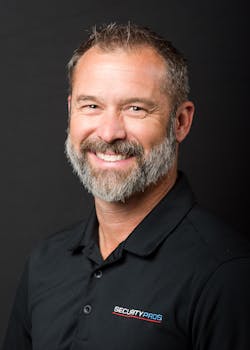Sponsored Roundtable: Cloud Video Surveillance
According to a report from research organization Gartner, businesses around the globe are expected to spend $304.9 billion on public cloud services in 2021, representing an 18.4% increase over 2020. Organizations are hastening their digital business transformation plans spurred on by on-demand, scalable cloud models that achieve cost efficiency and business continuity, the report said.
This exclusive technology roundtable sponsored by Eagle Eye Networks digs deeper to discuss how a true cloud video surveillance platform can reliably meet the requirements of enterprise customers, while delivering cybersecurity assurance, business intelligence, and the flexibility to change and scale systems to ensure investments are future-proof.
The Panel
- Chris Gilbert is Founder and President of Security Pros LLC, which offers intrusion detection, video surveillance, access control, and IP intercom solutions and services across Indiana.
- Lucas Ingala is Founder and CEO of Watchmen Security Services, providing a variety of security services to residential and commercial customers in and around Kansas City.
- Hans Kahler is VP of Business and Product Development for Eagle Eye Networks.
All kinds of businesses use cloud-based systems for ERP, CRM, and other systems; now, they are moving video surveillance systems to the cloud. What are the top benefits of this shift?
Gilbert: Depending on the market, vision of leadership, and long-term expectations of the organization, we are seeing that with the right vision, a hosted video solution can bring flexibility, expanded operational awareness and redundancy. An organization that has the flexibility to integrate its existing hosted systems has the ability to get a deeper understanding of the business and make its team members more effective in their day-to-day responsibilities.
Kahler: A cloud video surveillance system is easy to install and simple to configure, with little to no disruption to operations. In addition, customers appreciate that they can manage the system remotely and from one central location – granting and revoking user access, easily adjusting camera resolution and retention, and viewing, sharing, and managing video anytime, anywhere. The cloud also affords worry-free cybersecurity and compliance, enabling customers to focus on what’s important – managing and growing their business – and not their security system.
Ingala: The customer no longer has to upgrade hardware or pay for unnecessary service calls, and our team can be proactive in the event a video camera goes offline.
What are the top benefits of cloud video surveillance for resellers? What do you think about the subscription model?
Ingala: The top benefits include recurring monthly revenue (RMR), better customer experiences, and the fact that it is a differentiator. I think cloud surveillance aligns well with any business that is focused on RMR.
Kahler: Our resellers benefit from the simplified installation and maintenance intrinsic to cloud. Because management of the system is centralized, resellers also gain greater visibility into the system’s performance and health, while enjoying higher customer satisfaction and lower labor expenditure. As for the subscription model, resellers benefit by moving customers from a capital expenditure (CapEx) to an operational expenditure (OpEx) model. This is preferred by customers because it is more affordable, easier to budget and enables them to get into a new, modern video surveillance system without all the upfront expense.
How do you approach selling cloud video surveillance systems? Is it much different from selling traditional on-premises systems? How?
Kahler: Five years ago, I would have said, yes, selling cloud is different, because we had to convince end-users that cloud is legit; however, now customers understand the benefits of cloud technology, so they are demanding it for video surveillance. I think it is much easier today to sell cloud systems than traditional on-premises solutions.
Ingala: We approach it like selling anything else; however, it is a little different because you need to create the value of what cloud can do for them, like video backup, new features that are automatic, and health reporting.
Gilbert: I believe you have to commit – not only to the technology, but to the way of doing business. You must believe that what you are providing for your client is the right solution that solves their security, operational and company vision goals. Once that is established, cloud is just the solution and not an obstacle to overcome. Understand your customers and their needs, and the solution will present itself.
What vertical customers (either established or emerging) are most receptive to making the switch to cloud-based video and why?
Gilbert: I don’t believe it is market specific. I contend the company’s leadership, IT team and frontline managers must have a combined need and responsibility to operate on a platform that yields a different result than what our industry has provided over the years. Knowing how to identify the opportunity – not only for your company but also the client – is key to finding the right solution for the vertical and providing a niche solution.
What kinds of analytics and/or integrations are cloud video surveillance customers most interested in and why?
Gilbert: Depending on the market, people-counting and line crossing seem to represent the lion’s share of the requests. As we see hosted platforms evolve, I see a deeper integration with the edge analytics of the cameras to provide more advanced analytics, such as license plate capture and face and weapon detection. The emergence and accuracy of these technologies will help to expand the public safety aspects of our day-to-day lives and create safe environments for us all to enjoy.
Kahler: It depends on the vertical and customer situation, but we are seeing really successful integrations with point-of-sale (POS) systems, access control, and alarm monitoring. In addition, analytics for object detection, identification, and counting are very prevalent use cases.
Ingala: Having search tools that allow end-users to search faster, people counting tied in with API for scheduling staff, and intrusion detection zones for alerting are some of the key use cases we are seeing.
Is camera flexibility, including the option to use analog, important to your customers?
Kahler: It is extremely important, because the variety of customers out there and their widely varied situations make it difficult for one camera to address all needs.
Ingala: In a takeover scenario especially, the customer likes not being locked into any given camera and it makes it easier for us to sell.
Gilbert: In our opinion, using analog in today’s security environment is a result of not being educated in the real situations your clients face and not challenging your clients to think differently about the real events that will affect their businesses and overall operations. While there is considerable infrastructure out there today from legacy systems, it is key to use that infrastructure to provide clients with the right solution that will actually afford the level of security required for their businesses.
To learn more about Eagle Eye Networks, the leading provider of cloud video surveillance worldwide, visit www.een.com.




